Beyond Positions: A New Framework for Evaluating Basketball Prospects
From Floor Generals to Chaos Wings - A Role-Based System For Smarter Talent Identification and Projection
Basketball has always been a game of roles, but the way we define those roles has changed dramatically. The traditional five-position model of point guard, shooting guard, small forward, power forward, center was once sufficient to describe how players operated on the court. But in today’s game, those labels are increasingly obsolete. A 6ft 7in wing might initiate offense like a point guard, while a 6ft 2in guard might play exclusively off-ball. Positional size no longer dictates function, and versatility has become the currency of modern basketball.
This shift hasn’t made the game less structured but has instead made it more complex. Coaches now build systems around skill sets rather than positions. Scouts evaluate prospects based on usage, fit, and translatability, not just height and listed role. And players themselves are developing across multiple dimensions: guards who rebound like forwards, bigs who shoot like wings, wings who pass like point guards. The game has become a fluid mosaic of overlapping responsibilities.
To make sense of this evolution, we need a new language, one that goes beyond surface-level traits to describe how players actually impact the game. That’s where subarchetypes come in. This framework breaks players down not just by position group of guards, wings, forwards, bigs, but by function. It identifies what a player does, not just what they are. From tempo-shifting guards to chaos wings and rebounding engines, each of the 24 subarchetypes reflects a distinct role within modern basketball ecosystems.
Whether you're scouting high school prospects, analyzing college rotations, or projecting NBA roles, this system offers a sharper lens for understanding player value, team fit, and developmental trajectory. It’s not just about classification, it’s about clarity. And in a game that’s constantly evolving, clarity is power.
Guard Subarchetypes: Understanding the Backcourt Spectrum
The guard position has undergone the most dramatic transformation in modern basketball. Once narrowly defined by ball-handling duties and size thresholds, guards today span a vast spectrum of responsibilities, some initiate offense, others space the floor, and many specialize in defensive disruption or tempo control. The rise of positionless play hasn’t erased the need for structure; it’s simply shifted the focus from where a player lines up to how they function. In this framework, guards are no longer lumped together as “lead” or “combo”, instead they’re classified by their actual role within a system. This section introduces six distinct guard subarchetypes, each shaped by usage rate, skill emphasis, and tactical fit. From high-volume creators to low-usage connectors, these roles reflect the true diversity of modern backcourt play, and offer a sharper lens for evaluating talent, projecting development, and building coherent rotations.
Primary Initiator
The offensive engine. These guards carry high usage and are tasked with initiating nearly every possession. They thrive in pick-and-roll, collapse defenses, and create for both themselves and teammates. Their decision-making under pressure and ability to bend the defense are central to their value.
Traits: High-volume ball-handling, advanced reads, scoring gravity
NBA Examples: Luka Doncic, Tyrese Haliburton
2026 NBA Draft Examples: Mikel Brown Jr., Boogie Fland
Combo Scorer
These guards toggle between on-ball creation and off-ball scoring. They’re wired to get buckets—whether pulling up off the dribble, attacking closeouts, or finishing through contact. While they can pass, their primary value lies in their ability to generate offense for themselves.
Traits: Scoring versatility, shot creation, secondary playmaking
NBA Examples: Jamal Murray, Jalen Brunson
2026 NBA Draft Examples: Darryn Peterson, Darius Acuff Jr.
Micro Floor General
Undersized but cerebral, these guards control tempo, make smart reads, and elevate teammates without dominating usage. They’re often overlooked in box scores but essential to offensive flow. Their value lies in precision, not flair.
Traits: High assist-to-turnover ratio, leadership, system fluency
NBA Examples: Fred VanVleet, TJ McConnell
2026 NBA Draft Examples: Bennett Stirtz, Braden Smith
Tempo Shifter
Change-of-pace specialists who inject speed, unpredictability, and rhythm disruption. They thrive in transition and can flip a game’s momentum with their burst and flair. Often used as spark plugs off the bench or in dual-guard lineups.
Traits: Burst, transition scoring, momentum control
NBA Examples: De’Aaron Fox, Bones Hyland
2026 NBA Draft Examples: Tahaad Pettiford, Sergio de Larrea
Off-ball Mover
Guards who excel without the ball—relocating, cutting, and shooting off movement. They stretch defenses horizontally and vertically, often thriving alongside dominant initiators. Their value spikes in systems that emphasize spacing and ball movement.
Traits: Catch-and-shoot ability, off-ball IQ, movement gravity
NBA Examples: Desmond Bane, Seth Curry
2026 NBA Draft Examples: Matt Able, Ryan Conwell
Defensive Menace
Guards who set the tone defensively—pressuring ball handlers, jumping passing lanes, and creating chaos. They’re often undersized but play with relentless energy and anticipation. Their offensive role may be limited, but their defensive impact is game-changing.
Traits: Ball pressure, anticipation, motor
NBA Examples: Jrue Holiday, Davion Mitchell
2026 NBA Draft Examples: Dash Daniels, Kam Williams
Wing Subarchetypes: The Versatile Middle Layer
Wings are the connective tissue of modern basketball. They bridge the gap between guards and bigs, often tasked with defending multiple positions, spacing the floor, and adapting to a wide range of offensive and defensive schemes. In today’s game, wings are no longer defined by size alone—they’re defined by function. Some initiate offense, others specialize in disruption, and many thrive in low-usage roles that elevate stars around them. This section introduces six distinct wing subarchetypes, each designed to capture the diversity of responsibilities that fall between the backcourt and frontcourt. Whether you’re building a switch-heavy defense or a motion-heavy offense, understanding wing roles is essential to roster construction and player development.
Shot Creator
Scoring wings who thrive in isolation, mid-range pull-ups, and tough shot-making. They’re often the go-to option late in the clock and can carry offensive loads when needed. Their value lies in their ability to generate offense without relying on structure.
Traits: Isolation scoring, mid-range touch, self-creation
NBA Examples: Anrthony Edwards, Brandon Ingram
2026 NBA Draft Examples: AJ Dybantsa, Nate Ament
Slasher Connector
Athletic wings who attack closeouts, finish in transition, and keep the ball moving. They’re not primary creators but elevate lineups with energy, off-ball reads, and opportunistic scoring. Ideal in systems that emphasize pace and ball movement.
Traits: Downhill juice, transition finishing, connective passing
NBA Examples: Josh Hart, Bruce Brown
2026 NBA Draft Examples: Tounde Yessoufou, Alijah Arenas
3&D Specialist
Wings who space the floor and guard the opponent’s best perimeter threat. They’re low-maintenance, high-impact players who fit seamlessly into modern schemes. Their value spikes in lineups built around stars who need spacing and defensive support.
Traits: Catch-and-shoot ability, perimeter defense, low usage
NBA Examples: Mikal Bridges, OG Anunoby
2026 NBA Draft Examples: Braylon Mullins, Shon Abaev
Chaos Wing
Unpredictable, high-motor wings who disrupt games with deflections, transition bursts, and defensive versatility. They’re volatile but game-changing—capable of swinging momentum with a single play. Often thrive in up-tempo or pressure-heavy systems.
Traits: Defensive disruption, transition energy, motor
NBA Examples: Kelly Oubre Jr., Dillon Brooks
2026 NBA Draft Examples: Dwayne Aristode, Coen Carr
Playmaking Wing
Tall wings with passing vision and ball-handling chops. They initiate offense from the wing, often functioning as secondary creators or jumbo guards. Their versatility allows them to toggle between scoring and facilitating depending on matchup and scheme.
Traits: Vision, handle, secondary initiation
NBA Examples: Paul George, Franz Wagner
2026 NBA Draft Examples: Miles Byrd, Neoklis Avdalas
Defensive Switchblade
Wings who guard 1–4, crash the glass, and rotate instinctively. They’re defensive glue guys who thrive in switching schemes and cover for teammates. Their offensive role may be minimal, but their defensive versatility is foundational.
Traits: Positional flexibility, help instincts, rebounding
NBA Examples: Jaden McDaniels, Herb Jones
2026 NBA Draft Examples: Karim Lopez, Otega Oweh
Forward Subarchetypes: The Tactical Swiss Army Knives
Forwards are the most tactically flexible group in modern basketball. They operate in the margins—sometimes as oversized wings, sometimes as undersized bigs—and their value often lies in how well they adapt to system demands. In today’s game, forwards are rarely defined by traditional power forward traits. Instead, they’re judged by how they space the floor, defend in space, rebound, and connect actions. Some are mismatch hunters who isolate and score, others are glue guys who elevate stars without needing touches. This section introduces six distinct forward subarchetypes, each designed to reflect the layered responsibilities of this position group. Whether you’re building a switch-heavy defense, a five-out offense, or a motion-based system, understanding forward roles is essential to maximizing lineup versatility and roster synergy.
Stretch Forward
Floor-spacing forwards who shoot from deep and open driving lanes. They’re often pick-and-pop threats and secondary scorers who punish sagging defenses. Their shooting gravity reshapes spacing and unlocks offensive flow.
Traits: Catch-and-shoot ability, pick-and-pop versatility, off-ball value
NBA Examples: Jaren Jackson Jr., Bobby Portis
2026 NBA Draft Examples: Nikolas Khamenia, Thomas Haugh
Mismatch Hunter
Big wings or small-ball fours who exploit size or speed mismatches. They isolate, post up, or attack slower defenders with face-up scoring. Often used as scoring hubs in second units or matchup-specific lineups.
Traits: Isolation scoring, physicality, post versatility
NBA Examples: Tobias Harris, Kyle Kuzma
2026 NBA Draft Examples: Cam Boozer, Koa Peat
Connector Forward
Smart, versatile forwards who pass, defend, and rebound without dominating usage. They’re system players who elevate stars by filling gaps—making the extra pass, rotating defensively, and keeping possessions alive.
Traits: Passing IQ, defensive versatility, low usage
NBA Examples: Draymond Green, Deni Avdija
2026 NBA Draft Examples: Alvaro Folgueiras, Darrion Williams
Hybrid Defender
Switchable, athletic forwards who guard multiple positions and protect the rim. They’re defensive anchors in small-ball lineups and thrive in chaos—covering ground, rotating instinctively, and contesting shots across the floor.
Traits: Mobility, motor, positional flexibility
NBA Examples: Aaron Gordon, Jonathan Isaac
2026 NBA Draft Examples: Chris Cenac Jr., Yaxel Lendeborg
Point Forward
Forwards who initiate offense and make advanced reads. They blur positional lines, often functioning as jumbo playmakers with vision and poise. Their ability to handle and pass at size creates matchup problems and unlocks creative sets.
Traits: Ball-handling, vision, secondary initiation
NBA Examples: LeBron James, Scottie Barnes
2026 NBA Draft Examples: Caleb Wilson, Jalen Haralson
Rebounding Engine
High-motor forwards who dominate the glass, extend possessions, and bring physicality. They’re often undersized but relentless, thriving in transition and defensive rotations. Their value lies in effort, toughness, and possession control.
Traits: Rebounding, hustle, interior toughness
NBA Examples: PJ Washington, Jarred Vanderbilt
2026 NBA Draft Examples: Tammar Brown, Zuby Ejiofor
Big Subarchetypes: Anchors, Movers, and Spacers
Bigs remain the most role-dependent group in basketball. While the game has shifted toward spacing and mobility, the foundational responsibilities of rim protection, rebounding, and interior scoring still matter—just in more specialized forms. Today’s bigs are no longer defined solely by size or post play. Some stretch the floor, others switch on the perimeter, and many thrive as vertical spacers in pick-and-roll actions. The modern big must either anchor a defense, adapt to space, or bring elite energy in transition. This section introduces six distinct big subarchetypes, each reflecting a different way size and physicality translate into value. Whether you’re building a drop-coverage defense or a five-out offense, understanding big roles is essential to balancing rim presence with system flexibility.
Anchor Big
Traditional rim protectors who control the paint, block shots, and rebound. They thrive in drop coverage and half-court defense, providing structure and deterrence at the rim. Their offensive role may be limited, but their defensive impact is foundational.
Traits: Shot blocking, interior toughness, rebounding
NBA Examples: Rudy Gobert, Jakob Poeltl
2026 NBA Draft Examples: Jayden Quaintance, Flory Bidunga
Stretch Big
Bigs who shoot from deep and force defenses to guard in space. They open up driving lanes, enable five-out spacing, and offer pick-and-pop versatility. Their value lies in offensive gravity and lineup flexibility.
Traits: Catch-and-shoot ability, floor spacing, pick-and-pop threat
NBA Examples: Kristaps Porzingis, Al Horford
2026 NBA Draft Examples: Zvonimir Ivisic, Tomislav Ivisic
Roll Threat
Explosive finishers who thrive in pick-and-rolls, lob actions, and dunker spot duties. They’re vertical spacers who collapse defenses and finish through contact. Often paired with high-level initiators to maximize rim pressure.
Traits: Rim running, lob finishing, screen setting
NBA Examples: Clint Capela, Daniel Gafford
2026 NBA Draft Examples: Moustapha Thiam, Daniel Jacobsen
Post Hub
Skilled low-post scorers and passers who operate as offensive focal points. They draw doubles, facilitate from the block or high post, and provide structure in slower-paced systems. Their value spikes in matchups where interior creation is needed.
Traits: Post scoring, passing vision, interior footwork
NBA Examples: Nikola Jokic, Joel Embiid
2026 NBA Draft Examples: Pat Ngongba, Aday Mara
Switch Big
Mobile bigs who can guard guards on the perimeter and rotate in space. They’re essential in modern switching defenses and thrive in chaos—hedging, recovering, and contesting across multiple zones.
Traits: Lateral mobility, defensive versatility, recovery instincts
NBA Examples: Bam Adebayo, Evan Mobley
2026 NBA Draft Examples: Alex Condon, JoJo Tugler
Transition Big
Bigs who run the floor, finish in space, and rebound with urgency. They’re ideal for up-tempo systems and bring energy in early offense. Their motor and mobility make them valuable in fast-paced schemes and secondary break actions.
Traits: Rim running, rebounding, transition finishing
NBA Examples: Naz Reid, Onyeka Okongwu
2026 NBA Draft Examples: Magoon Gwath, Luigi Suigo
NBA Roster Building
NBA teams don’t build rosters by stacking talent, they build them by layering roles. A well-constructed lineup blends creators, connectors, spacers, and disruptors in a way that maximizes each player’s strengths while covering for their limitations. For example, pairing a Primary Initiator with an Off-ball Mover and a Roll Threat creates a clean offensive structure: one player bends the defense, one stretches it horizontally, and one collapses it vertically. Add a Defensive Switchblade and a Stretch Forward, and you’ve got a lineup that balances scoring, spacing, and defensive versatility. Subarchetypes give teams a vocabulary for building cohesion, not just collecting talent.
One of the most common mistakes in roster construction is role redundancy, stacking multiple players who occupy the same subarchetype without complementary skill sets. A team with three Shot Creators and no Connector Forwards may struggle with ball movement and defensive rotations. Similarly, pairing two Primary Initiators without off-ball gravity can lead to stagnant possessions and poor spacing. The best teams identify gaps in their subarchetype map and fill them intentionally, ensuring that each player adds a distinct layer of value to the system.
Subarchetypes aren’t just useful for lineup building, they’re essential for drafting and development. When teams understand what roles they need to fill, they can target prospects whose functional profiles match those gaps. A team with a high-usage guard might prioritize a Slasher Connector or 3&D Specialist to complement their star. Developmentally, knowing a player’s subarchetype helps coaches tailor growth plans: a Micro Floor General needs reps in tempo control and decision-making, while a Chaos Wing thrives with freedom and defensive autonomy. Role clarity accelerates growth.
Coaches often experiment with lineup combinations to discover new tactical identities. A small-ball unit might feature a Point Forward, two Playmaking Wings, and a Switch Big, creating a fluid, positionless attack. A defensive unit might lean on Defensive Menaces, Hybrid Defenders, and an Anchor Big to shut down opposing stars. These combinations aren’t random, they’re built on subarchetype synergy. Understanding how roles interact allows coaches to test systems with purpose, not just personnel.
Take, for example, the 2025 champion Oklahoma City Thunder who were constructed with surgical precision, blending elite creation, defensive versatility, and low-usage role players into a seamless system. At the core was Shai Gilgeous-Alexander, a Primary Initiator whose slashing and pick-and-roll mastery set the offensive tone. He was flanked by Combo Scorer Jalen Williams, who toggled between on-ball creation and off-ball spacing, and Defensive Menace Lu Dort, whose relentless perimeter defense anchored their identity. The frontcourt featured Switch Big Chet Holmgren, whose mobility and rim protection allowed for aggressive schemes, and Anchor Big Isaiah Hartenstein, who brought toughness, rebounding, and interior stability. With Alex Caruso off the bench as a Defensive Switchblade, OKC’s archetype blend allowed them to dominate both ends, never relying on star power alone, but on role synergy and tactical clarity.
Or, the 2024 champion Boston Celtics, who were constructed around a blend of elite perimeter defense, dual offensive initiators, and modern spacing principles. At the heart of their system was Jayson Tatum, functioning as a Playmaking Wing, a jumbo creator who could score from all three levels and initiate offense from the perimeter. Alongside him, Jaylen Brown filled the Shot Creator role, thriving in isolation and transition while providing secondary scoring punch. The backcourt featured Jrue Holiday as a Defensive Switchblade, guarding multiple positions and setting the tone on that end, and Derrick White as a Micro Floor General, controlling tempo and connecting actions with low-usage efficiency. In the frontcourt, Kristaps Porziņģis operated as a Stretch Big, spacing the floor with pick-and-pop gravity while offering rim protection that elevated Boston’s defensive ceiling. This lineup gave the Celtics a rare combination of switchability, shot-making, and role clarity, each player filled a distinct tactical need, and together they formed one of the most balanced starting fives of the modern era.
Summary
In a sport that’s constantly evolving, clarity is no longer a luxury, it’s a necessity. The traditional positional model served its purpose in a bygone era, but today’s game demands a more refined lens. The 24 subarchetypes outlined in this framework offer just that: a way to classify players not by where they stand on the court, but by what they do. Whether you’re scouting a high school guard, analyzing a college wing, or projecting an NBA big, understanding a player’s functional role is the key to evaluating fit, value, and developmental trajectory.
This framework is about translation. It helps coaches build coherent lineups, scouts identify translatable traits, and analysts decode the chaos of modern basketball. It’s a tool for seeing the game more clearly, and for speaking about it more precisely.
As the game continues to stretch, blur, and hybridize, the need for role-based language will only grow. These subarchetypes are a starting point, a foundation for deeper analysis, smarter development, and more intentional team-building. Because in the end, it’s not about positions. It’s about purpose.



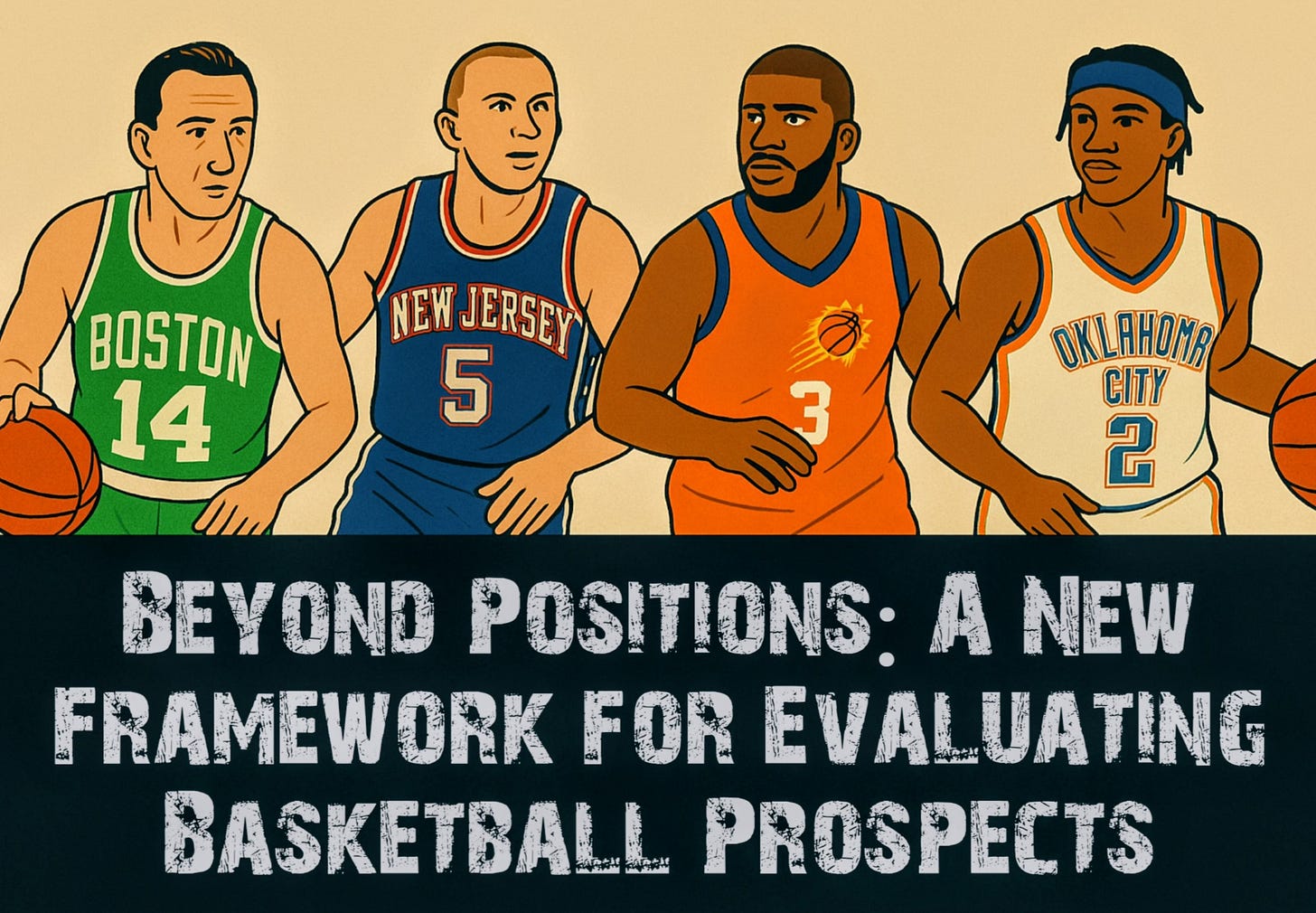
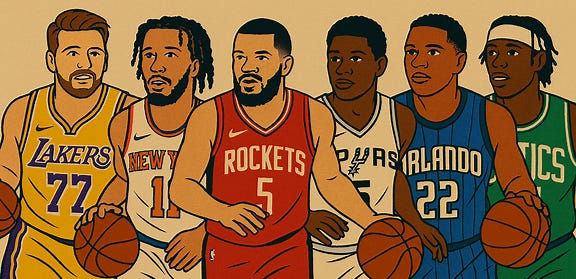
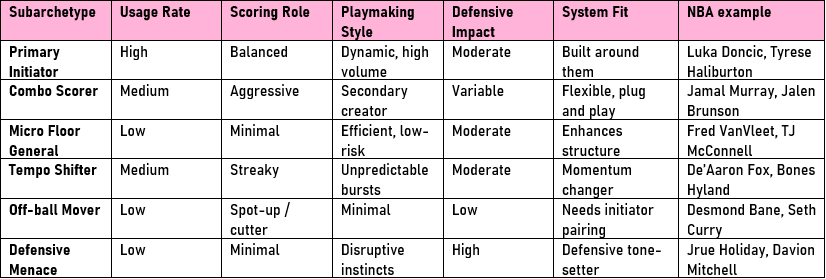
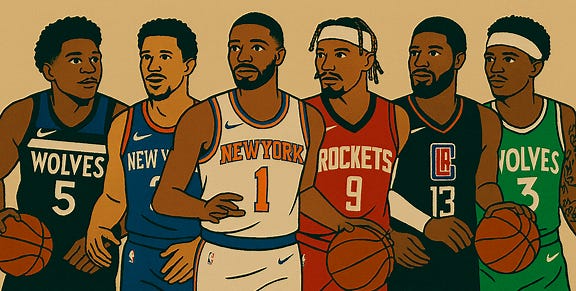

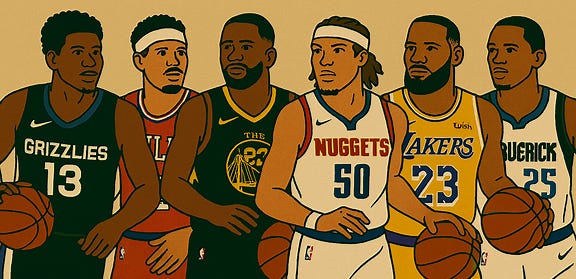
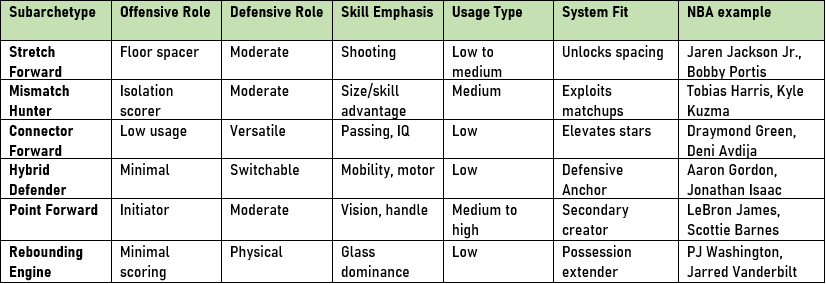

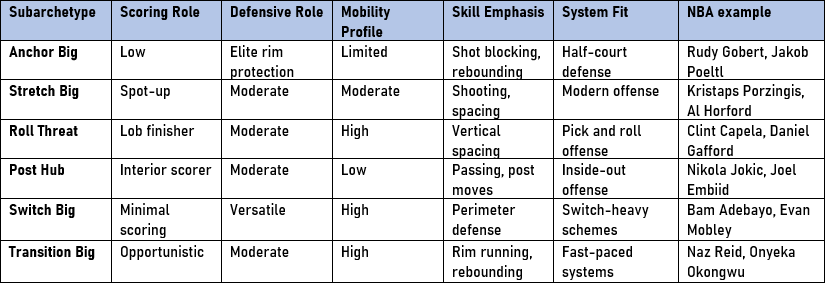
This was awesome!
Hi, that was an interesting article! Just a suggestion—how about categorizing them
by archetype like "Offense/Defense"?
For example:
Bam: Post Hub/Switch Big
Hart: Connector/Switch Blade
Holiday: Combo/POA
And so on...
Actually, I'm working on my own archetypes too.
It's great to find someone else thinking along the same lines!